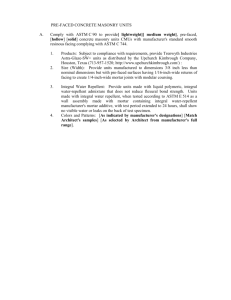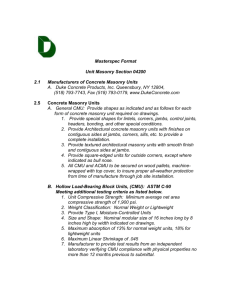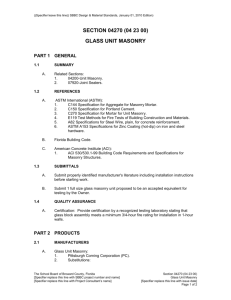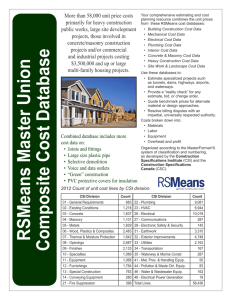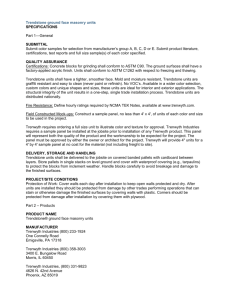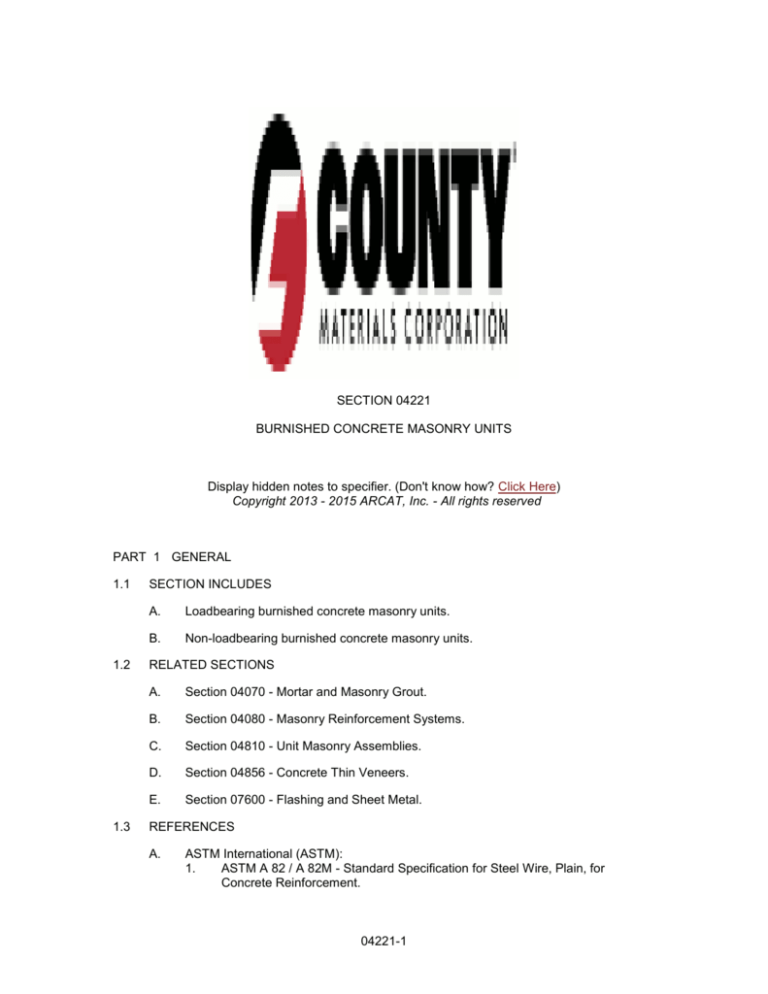
SECTION 04221
BURNISHED CONCRETE MASONRY UNITS
Display hidden notes to specifier. (Don't know how? Click Here)
Copyright 2013 - 2015 ARCAT, Inc. - All rights reserved
PART 1 GENERAL
1.1
1.2
1.3
SECTION INCLUDES
A.
Loadbearing burnished concrete masonry units.
B.
Non-loadbearing burnished concrete masonry units.
RELATED SECTIONS
A.
Section 04070 - Mortar and Masonry Grout.
B.
Section 04080 - Masonry Reinforcement Systems.
C.
Section 04810 - Unit Masonry Assemblies.
D.
Section 04856 - Concrete Thin Veneers.
E.
Section 07600 - Flashing and Sheet Metal.
REFERENCES
A.
ASTM International (ASTM):
1.
ASTM A 82 / A 82M - Standard Specification for Steel Wire, Plain, for
Concrete Reinforcement.
04221-1
12.
13.
14.
15.
16.
17.
1.4
1.5
ASTM C 207 - Standard Specification for Hydrated Lime for Masonry
Purposes.
ASTM C 270 - Standard Specification for Mortar for Unit Masonry.
ASTM C 476 - Standard Specification for Grout for Masonry.
ASTM C 920 - Standard Specification for Elastomeric Joint Sealants.
ASTM C 1330 - Standard Specification for Cylindrical Sealant Backing for Use
with Cold Liquid Applied Sealants.
ASTM D 2240 - Standard Test Method for Rubber Property - Durometer
Hardness.
B.
International Building Code (IBC).
1.
IBC - Chapter 7 Fire-Resistance-Rated Construction 721.3 Concrete
Masonry.
2.
IBC - Chapter 21 Masonry.
C.
Masonry Standards Joint Committee (MSJC):
1.
Building Code Requirements for Masonry Structures.
2.
Specifications for Masonry Structures.
D.
National Concrete Masonry Association (NCMA): TEK Manual for Concrete Masonry
Design and Construction.
E.
American Concrete Institute (ACI): ACI 117- Specification for Tolerances for
Concrete Construction and Materials.
SUBMITTALS
A.
Submit under provisions of Section 01300.
B.
Product Data: Manufacturer's data sheets on each product to be used, including:
1.
Storage and handling requirements and recommendations.
2.
Installation methods.
3.
Cleaning and maintenance instructions.
C.
Certificates: Certificate of Compliance to specified performance requirements.
D.
Test Reports:
1.
Dimensional Analysis.
2.
Absorption Analysis.
3.
Compressive Strength Analysis.
4.
Efflorescence Analysis.
E.
Verification Samples: For each product specified, two samples, representing types,
colors, textures, and finishes to be installed.
F.
USGBC LEED Submittals: Submit manufacturer's documentation of the following
items:
1.
MR Credit 4.1 and 4.2: Recycled content of products, indicating percentages
by weight of preconsumer and postconsumer recycled content, or
percentages of supplementary cementitious content.
2.
MR Credit 5.1 and 5.2: For projects within 500 miles of manufacturing location
where materials are extracted, processed and manufactured.
QUALITY ASSURANCE
A.
Regulatory Requirements and Approvals: provide applicable licensing, bonding or
other requirements of regulatory agencies.
04221-2
B.
1.6
1.7
Mock-Up: Provide a mock-up for evaluation of surface preparation techniques and
application workmanship.
1.
Construct a separate (not part of the actual building) sample wall panel not
less than 4 feet by 4 feet (1.2 m x 1.2 m) with units in the pattern, type, color,
texture, finish and shape as indicated on Drawings and specifications.
Cleaning agents and methods shall be performed prior to approval of the
sample panel.
2.
Do not proceed with remaining work until workmanship, patterns, types,
colors, textures, finishes and shape are approved by Architect. Maintain
Mock-up during construction for workmanship standard.
3.
Rework mock-up area as required to produce acceptable work.
DELIVERY, STORAGE & HANDLING
A.
Deliver, store and handle materials and products in strict compliance with
manufacturer's instructions and recommendations.
B.
Masonry units shall be delivered to the job site banded on wood pallets. Exposed
surfaces shall be protected and each cube shall be covered with a clear plastic
wrap. Protective mesh shall be placed between layers of block to guard against
damage. Pallets shall be stored in single-stacks on level ground. Delivered cubes
shall be protected from inclement weather with a waterproof covering. Units shall be
handled according to industry standards to minimize chipping and breakage.
C.
Handling: Units shall be handled in a manner that prevents breakage and damage.
PROJECT/SITE CONDITIONS
A.
Environmental Requirements:
1.
Protect CMUs from rain and freezing temperatures prior to, during, and for 48
hours after installation of materials.
2.
When ambient temperature is below 40 degrees F (4.4 degrees C) or
exceeds 90 degrees F (32.2 degrees C), comply with requirements for project
conditions in accordance with MSJC Specification for Masonry Structures
including the following:
a.
Par. 1.8 C. Cold Weather Construction.
b.
Par. 1.8 D. Hot Weather Construction.
3.
Do not continue masonry construction during heavy rains, as partially set or
plastic mortar is susceptible to washout until 8 to 24 hours of curing occurs
(depending upon environmental conditions).
4.
When rain is likely, cover construction materials. Newly constructed masonry
shall be protected from rain by draping a weather-resistant covering over the
assembly. The cover shall be secured in place and extend over mortar that is
susceptible to washout.
PART 2 PRODUCTS
2.1
MANUFACTURERS
A.
Acceptable Manufacturer: County Materials Corporation, which is located at: 205
North St. P. O. Box 100; Marathon, WI 54448-0100; Toll Free Tel: 800-289-2569;
Tel: 715-848-1365; Fax: 715-443-3691; Email: request info
(info@countymaterials.com); Web: www.countymaterials.com
B.
Substitutions: Not permitted.
C.
Requests for substitutions will be considered in accordance with provisions of
04221-3
Section 01600.
2.2
2.3
BURNISHED MASONRY UNITS
A.
Product: Premier Ultra Burnished masonry units as manufactured and distributed by
County Materials Corporation.
B.
Integrally Pigmented Burnished Units.
1.
Description: Normal weight, integrally pigmented hollow units with burnished
faces as scheduled or required and with a net area compressive strength of
greater than or equal to 1900 psi.
2.
Compliance: ASTM C 90.
3.
Coloring: Integral, through-body coloring; synthetic or natural iron oxide
pigments.
4.
Integral Polymer Emulsion Water Repellent as provided by manufacturer.
5.
Size and Shape: Full depth units as indicated on Drawings.
6.
Size and Shape: Oversize units as indicated on Drawings.
7.
Size and Shape: Thin veneer units as indicated on Drawings.
8.
Size and Shape: As indicated on Drawings.
9.
Color: Firebrush (63-215A).
10.
Color: Dawn (63-240A).
11.
Color: Quiet Beach (63-241A).
12.
Color: Sunrise (63-242A).
13.
Color: Dusk (63-243A).
14.
Color: Twilight (63-210B).
15.
Color: Moonbeam (63-214B).
16.
Color: Honeycomb (63-216B).
17.
Color: Echo (63-251B).
18.
Color: Burnt Embers (63-250B).
19.
Color: Deep Earth (63-252B).
20.
Color: Sea Salt (63-218C).
21.
Color: Solstice (63-219C).
22.
Color: North Star (63-222C).
23.
Color: Galaxy (63-239C).
24.
Color: As indicated on Drawings.
REINFORCEMENT AND ANCHORAGE
A.
Single-Wythe Joint Reinforcement for Single-Wythe Concrete Units:
1.
Truss Type; Fabricated from cold drawn steel wire ASTM A 82; conforming to
ASTM A 951; 9 gauge deformed side rods conforming to ASTM A 496 / A
496M; 9 gauge cross rods.
2.
Coatings for Corrosion Protection: Mill galvanized per ASTM A 641 /A 641M,
Zinc Coated (0.1 oz. per sq.ft.).
3.
Coatings for Corrosion Protection: Hot-dipped galvanized per ASTM A 153 / A
153M Class B.
4.
Acceptable Products: Or manufacturer approved equal.
a.
Truss Type Series 300 / 2 Wire System as manufactured by Wire Bond
b.
#120 Truss-Mesh as manufactured by Hohmann and Barnard, Inc.
5.
Width selected shall be approximately 2 inches (51 mm) less than nominal
width of Concrete Unit.
6.
Install continuously in horizontal mortar joints in vertical intervals of not more
than 16 inches (406 mm).
B.
Veneer Joint Reinforcement for Concrete Facing Units:
1.
Truss Type: Fabricated from cold drawn steel wire ASTM A 82; conforming to
ASTM A 951; 9 gauge deformed side rods conforming to ASTM A 496 / A
04221-4
2.
3.
4.
5.
6.
2.4
496M; 9 gauge cross rods.
Coating for Corrosion Protection: Mill galvanized per ASTM A 641 / A 641M,
Zinc Coated (0.1 oz. per sq.ft.).
Coating for Corrosion Protection: Hot-dipped galvanized per ASTM A 153 / A
153M Class B.
Acceptable Products: Or manufacturer approved equal.
a.
Truss Type Series 300 / 2 Wire System as manufactured by Wire Bond.
b.
#120 Truss-Mesh as manufactured by Hohmann and Barnard, Inc.
Width: Nominal 4 inch wire; actual - approximately 2 inches.
Install continuously in horizontal mortar joints in vertical intervals of not more
than 16 inches (406 mm) O.C.
C.
Veneer Anchors for Concrete Facing Units with CMU back-up: Ladder Type with
Ties.
1.
Truss Portion: Fabricated from cold drawn steel wire ASTM A 82; conforming
to ASTM A 951; 9 gauge deformed side rods conforming to ASTM A 496 / A
496M; 9 gauge cross rods.
a.
Hot-dipped galvanized per ASTM A 153 / A 153M Class B.
b.
3/16 inch (4.76 mm) diameter wire tabs shall be welded to truss portion
at 16 inch (406 mm) O.C. horizontal spacing.
2.
Ties: 3/16 inch (4.76 mm) diameter wire; Hot-dipped galvanized ASTM A 153
/ A 153M Class B.
3.
Acceptable Products: Or manufacturer approved equal.
a.
Ladder Type Series 800 / Hook-and-Eye as manufactured by Wire
Bond.
b.
#270 Ladder LOX-ALL as manufactured by Hohmann and Barnard, Inc.
4.
Truss width shall be approximately 2 inches (51 mm) less than nominal width
of Concrete Masonry Unit. Ties shall be of sufficient length to embed
longitudinal portion of tie into center of veneer +/- 1 inch (25 mm).
5.
Install continuously in horizontal mortar joints in vertical intervals of not more
than 16 inches (406 mm).
D.
Veneer Anchors for Concrete Facing Units with Steel Stud back-up: 2-Piece
anchors.
1.
Plate Portion: 14 gauge; Hot-dipped galvanized ASTM A 153 / A 153M Class
B.
2.
Ties: 3/16 inch (4.76 mm) diameter wire; Hot-dipped galvanized ASTM A 153
/ A 153M Class B.
3.
Products For Use Without Exterior-To-Studs Insulation: Or manufacturer
approved equal.
a.
Type III Anchor as manufactured by Wire Bond.
b.
DW-10HS as manufactured by Hohmann and Barnard, Inc.
4.
Products For Use With Exterior-To-Studs Insulation: X-Seal Anchors as
manufactured by Hohmann and Barnard, Inc. or manufacturer approved
equal.
5.
Ties shall be of sufficient length to embed longitudinal portion of tie into center
of unit veneer +/- 1 inch (25 mm).
6.
Install continuously in both horizontal and vertical intervals of not more than
16 inch (406 mm) O.C.
FLASHING
A.
Flashing for Single-Wythe Concrete Units:
1.
Embedded, overlapping, polypropylene pan system with integral weep spouts.
2.
Acceptable Products: Blok-Flash as manufactured by Mortar Net USA, Ltd or
manufacturer approved equal.
04221-5
3.
2.5
2.6
Flashing shall be installed at all locations where the free drainage of water is
blocked.
B.
Flashing for Concrete Facing Units:
1.
40-mil flexible flashing with integral drainage mat, stainless steel drip edge
and weep tabs.
2.
Acceptable Products: TotalFlash as manufactured by Mortar Net USA, Ltd. or
manufacturer approved equal.
C.
Weep Vents for Concrete Facing Units:
1.
2-5/8 inches x 3-1/2 inches x 1/2 inches (67 mm x 89 mm x 13 mm)
open-weave recycled polyester mesh.
2.
Product: Weep Vents as manufactured by Mortar Net USA, Ltd or
manufacturer approved equal.
3.
Weep Vents shall be installed a minimum of 32 inches (813 mm) O.C.
4.
Weep Vents color shall match color of the mortar joints.
GROUT
A.
Conventional Grout:
1.
Shall conform to ASTM C 476 and the recommendations of NCMA TEK 9-4A.
2.
Grout shall be proportioned to provide slump of 8 to 11 inches as measured
by ASTM C 143 / C 143M.
B.
Self-consolidating Grout: Shall conform to ASTM C 476 and MSJC.
MORTAR
A.
Mortar for Single-Wythe Concrete Units.
1.
Masonry Cement conforming to ASTM C 91, Type S.
2.
Cement - Lime.
a.
Portland Cement: ASTM C 150.
b.
Hydrated Lime ASTM C 207, Type S.
c.
Portland and Lime shall be mixed to meet ASTM C 270 property
specification Type S.
B.
Mortar for Concrete Facing Units:
1.
Masonry Cement conforming to ASTM C 91, Type N.
2.
Cement - Lime.
a.
Portland Cement: ASTM C 150
b.
Hydrated Lime ASTM C 207, Type S.
c.
Portland and Lime shall be mixed to meet ASTM C 270 property
specification Type N.
3.
Mortar Color: ____________.
4.
Mortar Color: Gray.
5.
Mortar Color: As indicated on Drawings.
6.
Joint Striking: __________.
7.
Joint Striking: Concave.
8.
Joint Striking: V-shaped.
9.
Joint Striking: As indicated on Drawings.
C.
Aggregate for Mortar: ASTM C 144.
D.
Water-Repellant Admixture: Liquid water-repellant mortar admixture or manufacturer
approved equal.
E.
Water: Clean and potable.
04221-6
2.7
2.8
CONTROL JOINTS
A.
Control Joints shall be built into Single-Wythe Concrete Unit walls according to the
recommendations of NCMA TEK 10-2C. Joints shall not exceed the lesser of: a
maximum panel length to height ratio of 1-1/2:1 or a distance of 25 ft (7.6 m).
B.
Control Joints shall be built into Concrete Facing Unit walls according to the
recommendations of NCMA TEK 10-4. Joints shall not exceed the lesser of: a
maximum panel length to height ratio of 1-1/2:1 or a distance of 20 ft (6.1 m).
C.
Control Joint Gasket: 2-5/8 inch (67 mm) PVC compound with 80 Durometer
hardness conforming to ASTM D 2240.
D.
Backer Rods: Backer rod diameter shall be 1/8 inch (3 mm) larger than width of the
control joint.
1.
Closed-cell polyethylene foam complying to ASTM C 1330, Type C.
2.
Acceptable Products: Sonolastic Closed-Cell Backer-Rod as manufactured by
Sonneborn or manufacturer approved equal.
E.
Sealant:
1.
Elastomeric polyurethane conforming to ASTM C 920.
2.
Acceptable Products: Sonolastic NP 2 as manufactured by Sonneborn or
manufacturer approved equal.
3.
Sealant Depth at midpoint shall be minimum 1/4 inch (6 mm); maximum 3/8
(9.5 mm).
4.
Sealant color shall match color of Concrete Unit Masonry.
SEALERS
A.
2.9
Sealer:
1.
Clear-drying, water-based, silicone emulsion with 6 percent solids as
measured by ASTM D 5095.
2.
Acceptable Products: SureKlean Weather Seal Blok-Guard & Graffiti Control
Ultra, as manufactured by PROSOCO or manufacturer approved equal.
CLEANERS
A.
Cleaners: Non muriatic acid cleaner.
B.
Cleaners: As applicable and after a test area is prepared.
1.
Acceptable Product: SureKlean Light Duty Concrete Cleaner (LDCC) as
manufactured by PROSOCO.
2.
Acceptable Product: NMD-80 as manufactured by EaCo Chem Inc.
PART 3 EXECUTION
3.1
EXAMINATION AND PREPARATION
A.
Examination:
1.
Verify field conditions are acceptable and ready to receive masonry.
2.
Verify the foundations or bearing elements are within tolerances conforming
to the requirements of ACI 117.
3.
Verify built-in items are in proper location, and ready to receive masonry work.
4.
Verify Concrete Masonry Units are according to project specification and meet
appropriate ASTM specification requirements. Commencement of installation
constitutes acceptance of Concrete Masonry Units.
B.
Preparation: Prepare surfaces and materials in accordance with MSJC
04221-7
Specifications for Masonry Structures. If preparation is the responsibility of another
installer, notify Architect in writing of deviations from manufacturer's recommended
installation tolerances and conditions.
C.
3.2
Do not proceed with installation until substrates have been properly prepared and
deviations from manufacturer's recommended tolerances are corrected.
Commencement of installation constitutes acceptance of conditions.
INSTALLATION
A.
Install only quality units; reject all defective units. Align units level, plumb and true
with uniform, carefully tooled 3/8 inch (9.5 mm) wide joints on the finished side of the
wall. Draw blocks from two or more pallets at a time during installation. Provide
adequate lighting for masonry work by placing all lighting a reasonable distance from
the wall for even illumination. Do not use trough lighting. Make all unit cuts, including
those for bonding, holes, boxes, etc., with motor-driven masonry saws, using either
an abrasive or diamond blade. Cut neatly for best appearance.
B.
Concrete Masonry Units:
1.
Install concrete masonry units in accordance with MSJC Specifications for
Masonry Structures and manufacturer's instructions.
2.
Bond Pattern for Exposed Masonry: Running Bond.
3.
Bond Pattern for Exposed Masonry: Stacked Bond.
4.
Bond Pattern for Exposed Masonry: As indicated on Drawings.
5.
Lay units by selecting product from more than one pallet at a time during
installation.
6.
Lay units with full mortar head and bed joints.
7.
All cutting shall be done with masonry saw to provide, clean, sharp,
unchipped edges.
8.
Do not use masonry units with broken corners and edges in excess of ASTM
C90.
9.
Temporary Formwork and Shores: Construct formwork to support reinforced
masonry elements during construction.
10.
Provide temporary bracing during installation of masonry work. Maintain in
place until building structure provides permanent bracing.
C.
Control Joints: Designed to reduce restraint and permit longitudinal movement. Per
NCMA Tek Note 10-2C and 10-4, proper control joint spacing is required for
concrete masonry walls.
1.
Single-Wythe Concrete Units: Joints shall not exceed the lesser of: a
maximum panel length to height ration of 1-1/2:1 or a distance of 25 feet.
2.
Concrete Facing Units: Joints shall not exceed the lesser of: a maximum
panel length to height ratio of 1-1/2:1 or a distance of 20 feet.
D.
Mortar and Mortar Joints:
1.
Mortar Mixing.
a.
Mix mortar ingredients in accordance with ASTM C270.
b.
Add mortar coloring.
c.
Add water repellent admixture specified by manufacturer.
d.
Mix mortar components between 3 and five minutes.
2.
Mortar Joints
a.
Tool exposed joints when mortar is thumbprint hard, using jointer larger
than joint thickness.
b.
Remove excess mortar smears as work progresses.
E.
Horizontal Joint Reinforcement:
1.
Place joint reinforcements in horizontal mortar joints in first course, at 8
04221-8
2.
3.
inches above and below openings, and below bearing locations.
Install joint reinforcement in the bed joints 16 inches (406 mm) on center
vertically in veneer applications, in the exterior wythe of composite and
noncomposite wall construction, and in through-wall masonry construction.
Nonstructural, horizontal, joint reinforcement should not be installed
continuously through control joints.
F.
Veneer Anchors and Ties: Install to allow for vertical and horizontal movement. Ties
must be securely attached to studs through sheathing and/or insulation and not to
the sheathing/insulation alone.
G.
Ambient Conditions: When ambient air temperature is outside the range of 40 to 90
degrees F (4.4 to 32.2 degrees C), implement procedures and comply with
recommendations in accordance with MSJC Specification for Masonry Structures.
H.
During construction and until the walls are roofed, the coping is installed, or the top
bond beam course is grouted solid, keep walls covered to prevent rain or snow
intrusion into the Concrete Unit cores or wall cavities.
I.
Keep Concrete units and walls clean during construction. Prevent grout or mortar
from staining the face of masonry. Mortar and grout soiling (droppings, spatters, and
smears) shall be removed at the end of each day following standard masonry
practices.
J.
Loading:
1.
Do not apply uniform floor or roof loads for a minimum of 12 hours after
building masonry walls.
2.
Do not apply concentrated loading for a minimum of 3 days after building
masonry walls or columns.
K.
Flashing and Weeps:
1.
Install flashing as indicated on drawings, as specified herein and in all of the
following locations:
a.
Above grade at base of walls.
b.
Under and behind sills.
c.
Over openings.
d.
At spandrels and shelf angles.
e.
On top of bond-beams if used mid-wall.
2.
Weep Vents shall be provided at all flashing locations at intervals not to
exceed 32 inches (813 mm) O.C.
L.
Cleaning:
1.
After mortar is thoroughly set and cured, clean Concrete Units explicitly
following manufacturer's recommended cleaning instructions.
2.
All caulking and sealant materials shall be in place and cured prior to
cleaning.
3.
Application of cleaner above 50 psi. is prohibited.
4.
Pressure rinse with 800 to 1000 psi at a water flow rate of 6-8 gallons per
minute and a 40 degree fan spray tip. Reduce water pressure to avoid
damage to delicate masonry.
5.
A test panel shall be cleaned and approved by architect prior to general wall
cleaning.
M.
Sealers:
1.
Apply one coat of sealer to surfaces after walls have been sufficiently cleaned
and after acceptance of the cleaning by the Architect. Follow manufacturer's
recommended application instructions including the following.
04221-9
2.
3.
4.
3.3
3.4
Apply a field coat of clear, solvent based sealer (Sure Klean Weather Seal
Blok-Guard & Graffiti Control Ultra) to all Premier Ultra Burnished Block to
maintain the limited warranty.
For a finished wall, apply a jobsite application of sealer to all Premier Ultra
Burnished walls after cleandown and when the walls are dry. Apply the sealer
evenly to cover the entire surface without forming drops or runs.
For maximum coverage and best appearance, apply with airless spray
equipment in accordance with the manufacturer's printed instructions. Clear,
solvent-based silicone elastomer shall be formulated to resist the elements
and effectively control efflorescence, mildew, and other moisture-related
stains on Premier Ultra Burnished Masonry Units; and to resist graffiti.
POINTING AND CLEANING
A.
Contractor shall keep masonry units, walls and surrounding work clean during
construction following standard masonry practices. Mortar soiling (including but not
limited to droppings, splatters, smears) shall be removed at the end of each day.
Remove mortar soiling from masonry work and connecting work before its final set.
Mortar droppings that adhere to the exposed face of the units shall be removed
using brick/block scrap after being allowed to harden, without causing damage to the
exposed face of installed units. Remaining mortar shall be removed with a stiff fiber
brush.
B.
At installation completion of Exposed Concrete Unit Masonry, tuck-point holes and
imperfections in joints of all exposed masonry surfaces, completely filling with
mortar. Tool to match surrounding mortar joints. After pointing hardens, and within
fourteen days of finished work, clean masonry surfaces of all excess mortar soiling
and dirt.
C.
All Concrete Masonry shall be cleaned in strict accordance with specified
manufacturer's instructions. Mild masonry detergents/cleaners and power washing
systems shall be properly used. Strong acids, acid washes, or chemicals with a
strong acid reaction shall not be used.
PROTECTION
A.
Protection:
1.
Protect installed work from damage due to subsequent construction activity
on the site.
2.
Protect masonry materials during storage and construction to prevent
moisture intrusion and soilage.
3.
During erection, cover tops of walls to prevent moisture penetration into cores
of Concrete Units and cavities of wall system.
4.
Provide final protection and maintain jobsite conditions that ensure Concrete
Masonry is without damage, deterioration, or soiling.
END OF SECTION
04221-10

